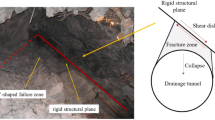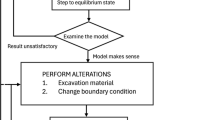Conclusions
-
1.
The characteristics of engineering-geological substantiation of underground hydraulic structure being constructed in the mountainous regions of Central Asia and the Caucasus are determined by the contemporatry tectonic, physical, and geological processes intensely occurring here. The engineering-geological information about the rock mass (the medium of the structures being designed) should be expressed in the form of models: at the predesign stage this is a general engineering-geological model and at the design stage a special geologicaltechnological model containing also recommendations optimizing the technology of driving the workings. During construction the geological-technological model should be refined on the basis of the engineering-geological documentation of the workings and the designs should be corrected accordingly.
-
2.
The main geomechanical problem of underground construction — an evaluation of the stability of the working and substantiation of the parameters of their support — must be solved with consideration of the natural stress state of the mass, σmax. The concept of relative strength of the rocks, n=σmax/Rc, is introduced. When n⩽0.3 failure of the mass in the vicinity of the working occurs in the form of relative displacement of the rock block along joints. The stability of a working can be evaluated by means of the theory of M. M. Protod'yakonov, in which case the strength coefficient (fca) is determined with consideration of the characteristics of the composition and state of the rock mass. When n>0.3 in the vicinity of the working failure of the rock in a specimen occurs. The solution of the problem of stability of a working in this case should be determined on the basis of physical theories describing the plastic deformation of the rocks.
-
3.
It was shown on the basis of considerable factual material that the thickness of the zone of decompression of rocks around a working as a function of its transverse dimensions has essentially a curvilinear character and depends on the parameters fca and n.
Similar content being viewed by others
Literature cited
A. A. Varga, “Certain problems of optimizing engineering-geological surveys in power construction for increasing the quality of designs,” Énerg. Stroit., No. 6, 55–58 (1984)
V. T. Glushko, V. P. Cherednichenko, and B. S. Ustenko, Rheology of a Rock Mass [in Russian], Naukova, Dumka, Kiev (1981), pp. 45–50.
Engineering-Geological Surveys for Construction of Hydraulic Structures [in Russian], Énergiya, Moscow (1980).
A. V. Kolichko, “Tensile strength of a jointed rock mass,” Tr. Gidroproekta, No. 33, 93–104 (1974).
A. V. Kolichko, “Use of the method of engineering-geological analogs for substantiating the designs of hydraulic structures,” Gidrotekh. Stroit., No. 6, 3–7 (1985).
L. A. Molokov, “Basic problems of methods and organization of engineering-geological surveys for substantiating the designs of long hydraulic tunnels,” Tr. Gidroproekta, No. 78, 10–15, 1981.
E. M. Pashkin, Engineering-Geological Investigations in Tunnel Construction [in Russian], Nedra, Moscow (1981).
M. I. Pogrebiskii and A. V. Kolichko, “Experience in engineering-geological regionalization of jointed rock masses (exemplified by the site of the Rogun hydroelectric station),” Tr. PNIIIS,23, (1972).
V. K. Razumov and S. S. Danielyan, “Comparison and analysis of the predicted and actual construction conditions of the Arpa-Seven tunnel,” Tr. Gidroproekta, 99–113 (1981).
V. K. Razumov, “Classification systems of evaluating the state of rock masses in construction of underground structures,” Tr. Gidroproekta, No. 113, 65–75 (1986).
Guide to Engineering-Geological Surveys for Construction of Underground Hydraulic Structures (11-771-82) [in Russian], Énergoatomizdat, Moscow (1984), p. 83.
SNiP 2.06.09-84 [in Russian] (1985), pp. 6–10.
Yu. A. Fishman, “Optimization of surveys on the basis of analyzing designs,” Gidrotekh. Stroit., No. 2, 11–15 (1982).
Yu. A. Fishman and L. S. Miroshnikova, “Experience in the development and use of engineering-geological models of hydrotechnical construction practice,” Inzh. Geol., No. 5, 24–37 (1984).
Additional information
Translated from Gidrotekhnicheskoe Stroitel'stvo, No. 2, pp. 29–32, February, 1987.
Rights and permissions
About this article
Cite this article
Kolichko, A.V., Razumov, V.K. Engineering-geological substantiation of the designs of underground hydrualic structures. Hydrotechnical Construction 21, 79–84 (1987). https://doi.org/10.1007/BF01424909
Issue Date:
DOI: https://doi.org/10.1007/BF01424909




